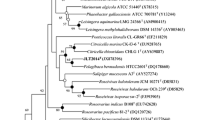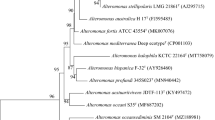Abstract
A bacterium which cleaves dimethylsulfoniopropionate (DMSP) to form dimethylsulfide (DMS) was isolated from surface Sargasso Sea water by a DMSP enrichment technique. The isolate, here designated LFR, is a Gram-negative, obligately aerobic, rod-shaped, carotenoid-containing bacterium with a DNA G+C content of 70%. Sequencing and comparison of its 16S ribosomal ribonucleic acid (rRNA) with that of known eubacteria revealed highest similarity (91% unrestricted sequence similarity) to Roseobacter denitrificans (formerly Erythrobacter species strain OCh114), an aerobic, bacteriochlorophyll-containing marine representative of the α-Proteobacteria. However, physiological differences between the two bacteria, and the current lack of other characterized close relatives, preclude assignment of strain LFR to the Roseobacter genus. Screening of fifteen characterized marine bacteria revealed only one, Pseudomonas doudoroffii, capable of degrading DMSP to DMS. Strain LFR is deposited with the American Type Culture Collection (ATCC 51258) and 16S rRNA sequence data are available under GenBank accession number 15345.
Similar content being viewed by others
References
Andreae MO (1990) Ocean-atmosphere interactions in the global biogeochemical sulfur cycle. Mar Chem 30: 1–29
Baumann L, Baumann P, Mandel M, Allen RD (1972) Taxonomy of aerobic marine enbacteria. J Bacteriol 110: 402–429
Baumann P, Baumann L (1981) The marine Gram-negative eubacteria: genera Photobacterium, Beneckea, Alteromonas, Pseudomonas, and Alcaligenes. In: Starr MP, Stolp H, Trüper HG, Balows A, Schlegel HG (eds) The prokaryotes. Springer-Verlag, Berlin Heidelberg, pp 1302–1331
Britschgi TB, Giovannoni SJ (1991) Phylogenetic analysis of a natural marine bacterioplankton population by rRNA gene cloning and sequencing. Appl Environ Microbiol 57: 1707–1713
Burdon, KL (1946) Fatty material in bacteria and fungi revealed by staining dried, fixed slide preparations. J Bacteriol 52: 665–678
Cantoni GL, Anderson DG (1956) Enzymatic cleavage of dimethylpropiothetin by Polysiphonia lanosa. J Biol Chem 222: 171–177
Challenger F, Simpson MI (1948) Studies on biological methylation. J Chem Soc 1948: 1591–1597
Dacey JWH, Blough NV (1987) Hydroxide decomposition of dimethylsulfoniopropionate to form dimethylsulfide. Geophys Res Lett 14: 1246–1249
DeSoete G (1983) A least squares algorithm for fitting additive trees to proximity data. Psychometrika 48: 621–626
Diaz MR, Visscher PT, Taylor BF (1992) Metabolism of dimethylsulfoniopropionate and glycine betaine by a marine bacterium. FEMS Microbiol Lett 96: 61–66
Dickson DM, Wyn Jones RG, Davenport J (1982) Osmotic adaptation in Ulva lactuca under fluctuating salinity regimes. Planta 155: 409–415
Dunlap PV (1984) The ecology and physiology of the light organ symbiosis between Photobacterium leiognathi and ponyfishes. Ph. D. Thesis, Univ California Los Angeles, 290 pp
Giovannoni SJ, Britschgi TB, Moyer CL, Field KG (1990) Genetic diversity in Sargasso Sea bacterioplankton. Nature 345: 60–62
Guillard RRL (1975) Culture of phytoplankton for feeding marine invertebrates. In: Smith WL, Chanley MH (eds) Culture of marine invertebrate animals. Plenum Press, New York, pp 29–60
Harashima K, Kawazoe K, Yoshida I, Kamata H (1987) Light-stimulated aerobic growth of Erythrobacter species OCH 114. Plant Cell Physiol 28: 365–374
Herdman M, Janvier M, Waterbury JB, Rippka R, Stanier RY, Mandel M (1979) Deoxyribonucleic acid base composition of cyanobacteria. J Gen Microbiol 111: 63–71
Hobbie JE, Daley RJ, Jasper S (1977) Use of Nuclepore filters for counting bacteria by fluorescence microscopy. Appl Environ Microbiol 33: 1225–1228
Hultman T, Stahl S, Hornes E, Uhlen M (1989) Direct solid phase sequencing of genomic and plasmid DNA using magnetic beads as solid support. Nucl Acids Res 17: 4937–4946
Ishida Y (1968) Physiological studies on evolution of dimethyl sulfide from unicellular marine algae. Mem Coll Agric Kyoto 94: 47–82
Kiene RP (1990) Dimethyl sulfide production from dimethylsulfoniopropionate in coastal seawater samples and bacterial cultures. Appl Environ Microbiol 56: 3292–3297
Kiene RP, Service SK (1991) Decomposition of dissolved DMSP and DMS in estuarine waters: Dependence on temperature and substrate concentration. Mar Ecol Prog Ser 76: 1–11
Lane DJ (1991) 16S/23S rRNA sequencing. In: Sackebrandt E, Goodfellow M (eds) Nucleic acid techniques in bacterial systematics. John Wiley and Sons, New York, pp 115–147
Mason TG, Blunden G (1989) Quaternary ammonium and tertiary sulphonium compounds of algal origin as alleviators of osmotic stess. Bot Mar 32: 313–316
Mayfield CI, Inniss WE (1977) A rapid, simple method for staining bacterial flagella. Can J Microbiol 23: 1311–1313
Medlin L, Elwood HJ, Stickel S, Sogin ML (1988) The characterization of enzymatically amplified eukaryotic 16S-like rRNA coding regions. Gene 71: 491–499
Nealson KH (1978) Isolation, identification, and manipulation of luminous bacteria. Meth Enzymol 57: 153–166
Okamura K, Takamiya K, Nishimura M (1985) Photosynthetic electron transfer system is inoperative in anaerobic cells of Erythrobacter species strain OCh114. Arch Microbiol 142: 12–17
Okamura K, Miyata T, Iwanaga S, Takamiya K, Nishimura M (1987) Complete amino acid sequence of cytochrome c 551 from Erythrobacter species OCh114. J Biochem 101: 957–966
Olsen GJ, Overbeek R, Larsen N, Marsh TL, McCaughey MJ, Maciukenas MA, Kuan W, Macke TJ, Xing Y, Woese CR (1992) The ribosomal RNA database project. Nucl Acids Res 20: 2199–2200
Ruby EG, Nealson KH (1971) Symbiotic association of Photobacterium fischeri with the marine luminous fish Monocentris japonica: A model of symbiosis based on bacterial studies. Biol Bull 151: 574–586
Saiki RK, Gelfand DH, Stoffel S, Scharf SJ, Higuchi R, Horn GT, Mullis KB, Erlich HA (1988) Primer-directed enzymatic amplification of DNA with a thermostable DNA polymerase. Science 239: 487–491
Schmidt TM, DeLong EF, Pace NR (1991) Analysis of a marine picoplankton community by 16S rRNA gene cloning and sequencing. J Bacteriol 173: 4371–4378
Shiba T (1989) Taxonomy and ecology of marine bacteria. In: Harashima K, Shiba T, Murata N (eds) Aerobic photosynthetic bacteria. Japan Scientific Societies Press, Tokyo, and Springer, Berlin, pp 9–24
Shiba T (1991) Roseobacter litoralis gen. nov., sp. nov., and Roseobacter denitrificans sp. nov., aerobic pink-pigmented bacteria which contain bacteriochlorophyll a. System Appl Microbiol 14: 140–145
Shiba T, Simidu U (1982) Erythrobacter longus gen. nov., sp. nov., an aerobic bacterium which contains bacteriochlorophyll a. Int J Syst Bacteriol 32: 211–217
Shiba T, Simidu U, Taga N (1979) Distribution of aerobic bacteria which contain bacteriochlorophyll a. Appl Environ Microbiol 38: 43–45
Taylor BF, Gilchrist DC (1991) New routes for aerobic biodegradation of dimethylsulfoniopropionate. Appl Environ Microbiol 57: 3581–3584
Turner SM, Malin G, Liss PS, Harbour DS, Holligan PM (1988) The seasonal variation of dimethylsulfide and dimethylsulfoniopropionate concentrations in nearshore waters. Limnol Oceangr 30: 364–375
Vairavamurthy A, Andreae MO, Iverson RL (1985) Biosynthesis of dimethylsulfide and dimethylsulfoniopropionate by Hymenomonas carterae in relation to sulfur source and salinity variations. Limnol Oceanogr 30: 59–70
Wakeham SG, Howes BL, Dacey JWH, Schwarzenbach RP, Zeyer J (1987) Biogeochemical cycling of dimethyl sulfide in a seasonally stratified coastal salt pound. Geochim Cosmochim Acta 51: 1675–1684
Weeks DP, Beerman N, Griffith OM (1986) A small-scale five hour procedure for isolating multiple samples of CsCl-purified DNA. Anal Biochem 152: 376–385
Woese CR (1987) Bacterial evolution. Microbiol Rev 51: 221–271
Woese CR, Stackebrandt E, Weisburgh WG, Paster BJ, Madigan MT, Fowler VJ, Hahn CM, Blanz P, Gupta R, Nealson KH, Fox GE (1984) The phylogeny of purple bacteria: the alpha subdivision. System Appl Microbiol 5: 315–326
Yayanos AA, Dietz AS, van Boxtel R (1982) Dependence of reproduction rate on pressure as a hallmark of deep-sea bacteria. Appl Environ Microbiol 44: 1356–1361
Author information
Authors and Affiliations
Additional information
Contribution no. 8337 of the Woods Hole Oceanographic Institution
Rights and permissions
About this article
Cite this article
Ledyard, K.M., DeLong, E.F. & Dacey, J.W.H. Characterization of a DMSP-degrading bacterial isolate from the Sargasso Sea. Arch. Microbiol. 160, 312–318 (1993). https://doi.org/10.1007/BF00292083
Received:
Accepted:
Issue Date:
DOI: https://doi.org/10.1007/BF00292083




